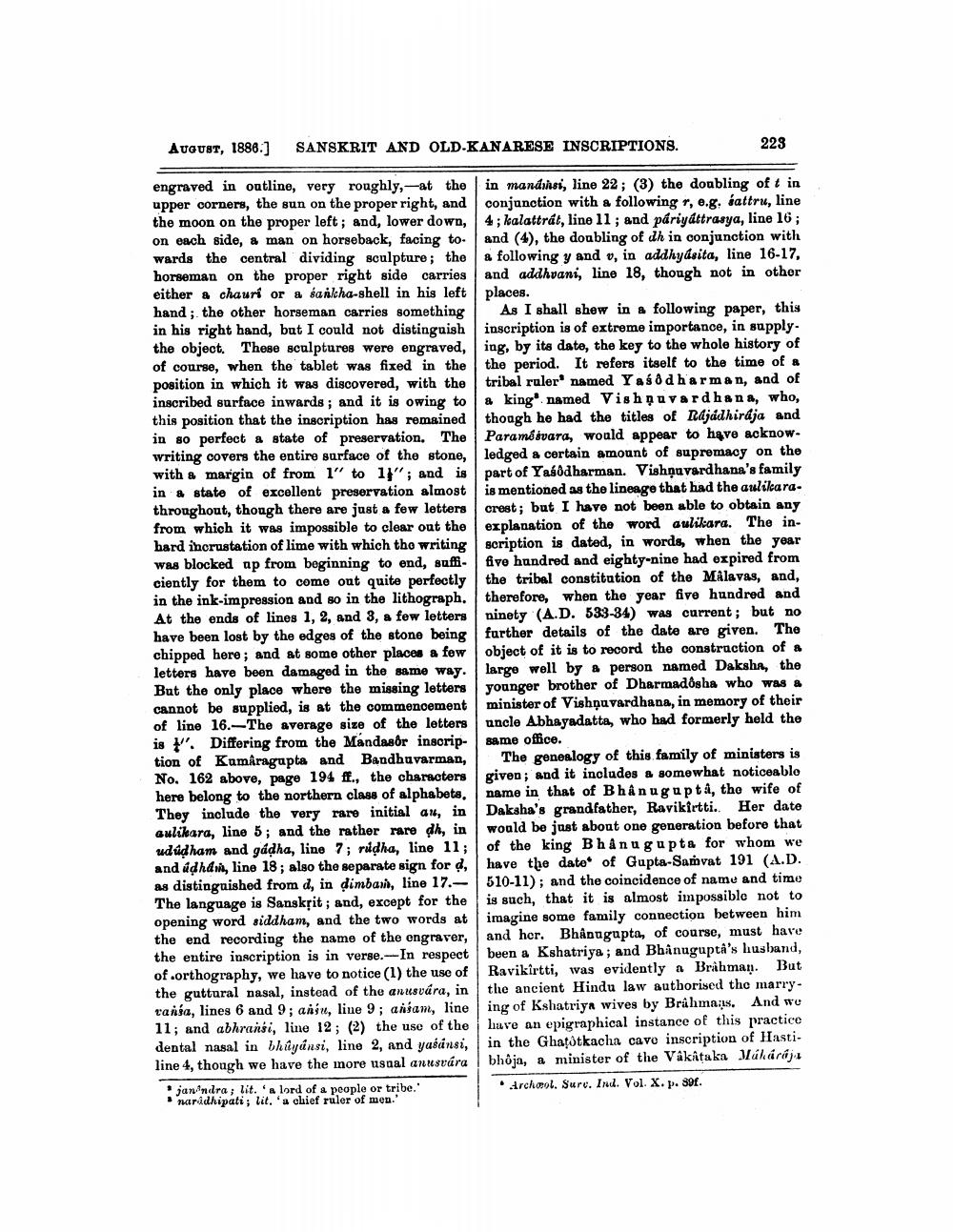________________
AUGUST, 1886.)
SANSKRIT AND OLD-KANARESE INSCRIPTIONS.
223
engraved in outline, very roughly,--at the in mandinsi, line 22; (3) the doubling of t in upper corners, the sun on the proper right, and conjunction with a following r, e.g, sattru, line the moon on the proper left; and, lower down, 4; kalattrát, line 11; and páriyattrasya, line 16; on each side, a man on horseback, facing to and (4), the doubling of dh in conjunction with wards the central dividing sculpture; the following y and v, in addhydsita, line 16-17, horseman on the proper right side carries and addhvani, line 18, though not in other either & chauri or a sankha-shell in his left places. hand; the other horseman carries something As I shall show in a following paper, this in his right hand, but I could not distinguish inscription is of extreme importance, in supplythe object. These sculptures were engraved, ing, by its date, the key to the whole history of of course, when the tablet was fixed in the the period. It refers itself to the time of a position in which it was discovered, with the tribal ruler named Yaśdd harman, and of inscribed surface inwards; and it is owing to a king' named Vishnuvardhana, who, this position that the inscription has remained though he had the titles of Rajadhiraja and in so perfect a state of preservation. The Paramo svara, would appear to have acknowwriting covers the entire surface of the stone, ledged a certain amount of supremacy on the with a margin of from 1" to ly; and is part of Yasodharman. Vishnuvardhana's famil in & state of excellent preservation almost is mentioned as the lineage that had the aulikara. throughout, though there are just a few letters crest; but I have not been able to obtain any from which it was impossible to clear out the explanation of the word aulikara. The inhard incrustation of lime with which the writing scription is dated, in words, when the year was blocked ap from beginning to end, suffi. five hundred and eighty-nine had expired from ciently for them to come out quite perfectly the tribal constitution of the Mâlavas, and, in the ink-impression and so in the lithograph, therefore, when the year five hundred and At the ends of lines 1, 2, and 3, a few letters ninety (A.D. 533-34) was current; but no have been lost by the edges of the stone being further details of the date are given. The chipped here; and at some other places a few object of it is to record the construction of a letters have been damaged in the same way. large well by a person named Daksha, the But the only place where the missing letters younger brother of Dharmadôsha who was a cannot be supplied, is at the commencement minister of Vishņuvardhana, in memory of their of line 16.-The average size of the letters uncle Abhayadatta, who had formerly held the is . Differing from the Mandasör inscrip- same office. tion of Kamâragupta and Bandhuvarman, The genealogy of this family of ministers is No. 162 above, page 194 ff., the characters given; and it includes a somewhat noticeablo here belong to the northern class of alphabets, name in that of Bhânugupta, the wife of They include the very rare initial an, in Daksha's grandfather, Ravikirtti. Her date aulikara, line 5; and the rather rare dh, in would be just about one generation before that udúdham and gadha, line 7; ridha, line 11; of the king Bhanu gupta for whom we and adhdmi, line 18; also the separate sign for d, have the date of Gupta-Samvat 191 (A.D. as distinguished from d, in dimbara, line 17.- 510-11); and the coincidence of name and time The language is Sansksit; and, except for the is such, that it is almost impossible not to opening word siddham, and the two words at imagine some family connection between him the end recording the name of the engraver, and her. Bhậnugupta, of course, must have the entire inscription is in verse.--In respect been a Kshatriya; and Bhinugupta's husband, of.orthography, we have to notice (1) the use of Ravikirtti, was evidently a Brahman. But the guttural nasal, instead of the anusvára, in the ancient Hindu law authorised the marryransa, lines 6 and 9; ansu, line 9; ansam, line ing of Kshatriya wives by Brahma. And wo 11; and abhransi, line 12; (2) the use of the have an epigraphical instance of this practice dental nasal in bhaiyánsi, line 2, and yasinsi, in the Ghatotkacha cavo inscription of Hastiline 4, though we have the more usual anusvára | bhoja, a minister of the Vâkataka Múhárája jan Andra; lit. 'a lord of a people or tribe.
Archool. Sure. Ind. Vol. X. p. 3of. naridhipati; lit. 'a chief ruler of men."




